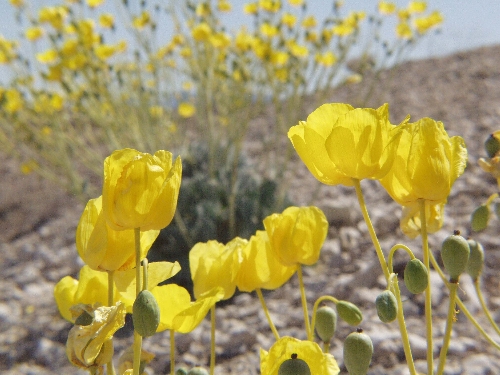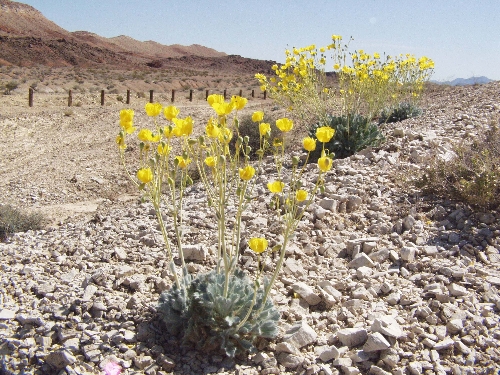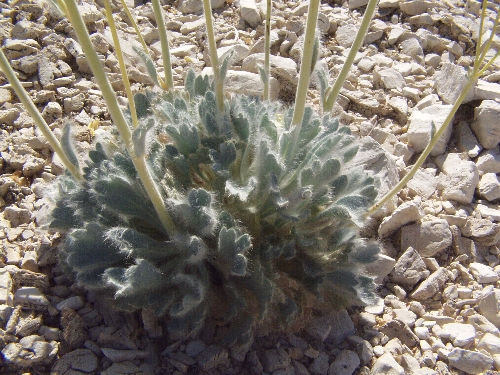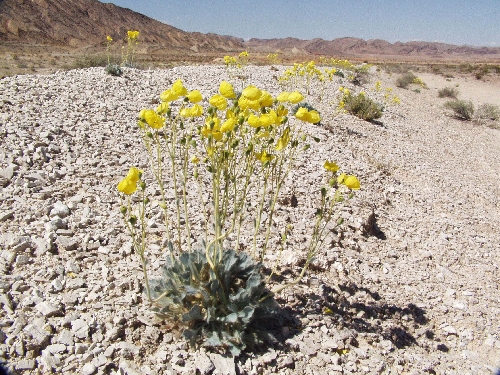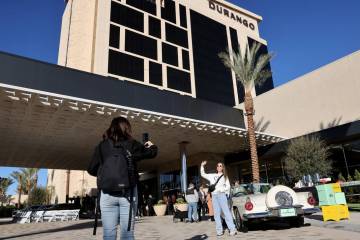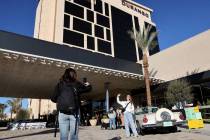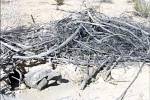Clark County hills are alive with rare bearpaw poppy blooms
If you look quick, you still might be able to see a bearpaw poppy in bloom this year, but it may take some work. This rare plant blooms for only a few weeks each year and grows almost exclusively in Clark County .
"How long a bloom will last depends on the year and the amount of heat," said Rob Mrowka, a conservation advocate with the Center for Biological Diversity. "On a good year, an individual flower can last a little over a week. On a bad year, like this one where it's dry and hot, it might last three to five days."
The good news for people interested in seeing one is that each plant has a multitude of blossom buds, so a plant can be in bloom for weeks.
The bearpaw poppy features a cluster of light green leaves with soft "fur," which somewhat resembles the titular bear paw. When it blooms, stalks up to 2 feet tall grow out of the cluster and are topped with a brilliant yellow flower.
The Latin name for the plant is "Arctomecon californica," although the plant doesn't grow in California. Its native areas range from Gold Butte, south of Mesquite, to parts of the Lake Mead National Recreation Area. The plant was discovered by John C. Fremont and was named for the Mexican Territory that the Las Vegas Valley was part of at that time.
"They're protected as critically endangered," Mrowka said. "There are conservation actions in place at the county and state level."
On an April 20 trip to Rainbow Gardens, an area accessible only by four-wheel drive vehicles on the east side of Frenchman Mountain, Terri Robertson, Sunrise Manor resident and vice president of the Friends of Gold Butte, was startled by the large patch of bearpaw poppies.
"I've never seen this many in one place," said Robertson, an environmentalist and lifelong Clark County resident. "The individual plants in Gold Butte are bigger, but this is just amazing."
The plant only grows in gypsum soil, and it can't be transplanted. It often grows in the seemingly inhospitable environment of sharp shards of gypsum ore. Although the plant has never been successfully transplanted, it can be grown from seed, given the right conditions.
Mrowka said destroying the plants or their habitat requires a permit and that part of the Clark County conservation plan was a requirement that developers who had plans that would destroy a bearpaw poppy habitat are required to save the topsoil, where the seeds are, for relocation to another viable growing spot. Among the places where the bearpaw poppy habitat has been successfully relocated is the Springs Preserve at 333 S. Valley View Blvd.
"The most visible natural population is in the Upper Las Vegas Wash in North Las Vegas," Mrowka said. "That's included in the area that's being proposed as a national monument. There's also a protected area on the North Las Vegas Airport on the land buffering the runways."
The proposed Tule Springs Ice Age Park, near the Clark County Shooting Complex on the north end of Decatur Boulevard, would also protect Ice Age mammal fossils and another endemic plant : the Las Vegas buckwheat.
When in bloom, bearpaw poppies can also be easily seen along Pabco Road, which can be reached by heading over the pass from Sunrise Manor to the Lake Mead National Recreation Area on Lake Mead Boulevard and turning left on Pabco Road.
"These are a rare treat that only we get to see," Robertson said. "Even then, you have to work a bit to see them."
Contact Sunrise/Whitney View reporter F. Andrew Taylor at ataylor@viewnews.com or 380-4532.



